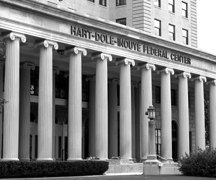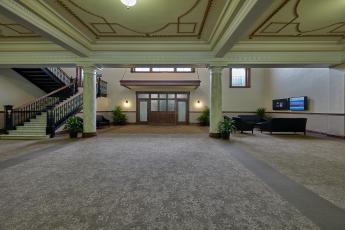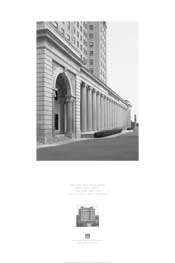Location: 74 N Washington Ave, Battle Creek, MI 49037
History
The Hart-Dole-Inouye Federal Center, formerly the Battle Creek Federal Center, has a colorful history intertwined with notable Americans. The property successively served as a sanitarium, military hospital, and offices. The Seventh Day Adventists established the Western Health Reform Institute in a cottage on the site in 1866 to espouse the ideals of temperance and preventative medicine. In 1876, Dr. John Harvey Kellogg, medical director, renamed the property Battle Creek Sanitarium and expanded the facility to include a hospital, central building, and other cottages. Kellogg emphasized the importance of fresh air, exercise, rest, and a restricted diet in maintaining physical health. He experimented in other pioneering medical and scientific techniques. While he may be memorable for his work with his brother developing cereals, Kellogg reportedly was one of the first physicians to treat cancer with radium.
Much of the original sanitarium burned in 1902. A large building by architect Frank M. Andrews opened in 1903 at a cost of $1 million and was considered a marvel of modern planning and medical technology. Under Kellogg’s auspices, the sanitarium expanded and a tower addition was completed in 1928. Despite Kellogg’s medical and scientific intentions, the sanitarium was used primarily as a spa by the rich and famous. Guests included Henry Ford and President William Taft.
The U.S. Army purchased the property for $2.25 million in 1942 and converted it into a hospital to treat World War II soldiers. It was named the Percy Jones Army Hospital after the renowned colonel who pioneered modern battlefield ambulance evacuation and was instrumental in creating the U.S. Army Ambulance Corps. After treating nearly 95,000 patients, the hospital closed in 1953.
In 1954, the Federal Civil Defense Administration moved on site, and numerous Federal agencies now occupy it. The 1903 building was listed in the National Register of Historic Places in 1974. In 2003, the complex was renamed to honor three U.S. Senators who were patients there during World War II: Philip Hart of Michigan, Robert Dole of Kansas, and Daniel Inouye of Hawaii.
Architecture
The Hart-Dole-Inouye Federal Center includes 21 buildings on 24 acres. Building types include offices, a power plant, workshops, and storage buildings. The main 1903 sanitarium building has a rectangular footprint with three wings radiating out from the main block. It is now referred to as Building 2, with the wings designated as Buildings 2A, 2B, and 2C. It is designed in the Italian Renaissance Revival style, which was commonly used for academic buildings in the early twentieth century. This was a logical choice for the sanitarium since Dr. Kellogg sought to educate his patients in the ways of healthy living.
The facade is composed of buff-colored brick with decorative details such as piers, belt courses, and quoins (corner blocks) executed in gray brick. Decorative pediments (triangular gables) are above entrances. Concrete columns mark the main entrance bay and are topped with plaster Ionic (scrolled) capitals. Arched openings form loggias, which are roofed spaces with open sides. The monumental building occupies a high point in the city and was originally five stories in height, with a compatibly designed sixth story added in 1920. Despite the changes in use, the building’s exterior has not been altered substantially.
The first-floor lobby has an ornate plaster ceiling. The east wall of the lobby contains a tripartite leaded glass window; the center portion bears the inscription “He is Thy Life.” The stairway to the mezzanine has a cast-iron balustrade with a wood railing and marble steps. The newel post contains classically inspired ornamentation appropriate to the building style.
The sixth-floor lobby contains four murals painted by J.J. Haidt in 1922. They are located on the coved ceiling and depict serene landscape scenes in pastel colors. Other interior spaces have changed dramatically. The solarium, gymnasium, and swimming pool have been removed.
The most prominent feature of the complex is the 15- story tower that was added to the south side of Building 2 in 1928. The tower, currently designated as Building 1, was designed to complement the existing main sanitarium building. The exterior remains unchanged and is clad in stone and different shades of brick. The facade is dominated by a two-story colonnade with 32 Ionic columns. Porte cochere pavilions are located at each end of the colonnade. The tower originally contained more than 265 hotel-like guest rooms and suites, most of which had private bathrooms. These spaces have been altered to accommodate government offices. The luxurious two-story lobby of the tower has twelve massive marble columns with imported Italian marble bases. The columns are topped with Corinthian capitals that feature acanthus leaf designs. The ceiling in the lobby is coffered (recessed) and detailed with floral motifs executed in rich colors. The lobby walls are covered with pink-gold marble, and gold chandeliers illuminate the space. Tall windows open to the colonnade. Building 1A was originally the sanitarium’s lavish dining room. It retains many original features including large chandeliers and murals of Oriental scenes. Draperies, doors, and decorative moldings have been restored. The room retains much of its original character and serves as a cafeteria today.
Significant Events
- 1866: Sanitarium opens
- 1902: Fire destroys earliest buildings
- 1903: New five-story building completed
- 1920: Sixth story added to main building
- 1928: Tower completed
- 1942: U.S. Army purchases site for use as hospital
- 1954: Federal Civil Defense Administration moves into complex
- 1974: Buildings 2, 2A, 2B, and 2C listed in the National Register of Historic Places
- 1996: Interior renovation completed
- 2003: Complex renamed Hart-Dole-Inouye Federal Center
Facts
- Architects: Frank M. Andrews; Merritt Morehouse
- Architectural Style: Italian Renaissance Revival
- Construction Dates: 1902-1903; 1920; 1928
- GSA Building Number: MI0503BC
- National Register of Historic Places Landmark Status:
- Landmark Status: Buildings 2, 2A, 2B, and 2C listed in the National Register of Historic Places; Buildings 1 and 1A eligible for listing in the National Register of Historic Places
- Primary Material: Buff-Colored Brick
- Prominent Features: 15-Story Tower Ionic Colonnade
Poster Download
Download the poster [PDF - 637 KB]

 U.S. General Services Administration
U.S. General Services Administration


